Diving - The Galapagos Islands - Trip of a lifetime!
Day 6 : Punta vicente Roca, Isabella Island - Mola Mola!
The following morning we found ourselves moored up, back at Isabella Island, but on the North Western edge at a site called Punta vicente Roca.
This dive had the very specific purpose of looking for Mola Mola.
On entry, vis was very milky and my immediate thought was that we would see nothing but quite quickly we spotted the shape of a good sized Mola Mola above us.
Before that I spotted and videoed a Bullhead Shark
Moving on Daniel pointed out other Molas as we went, a surprisingly high number (probably a dozen or so over the dive) considering how rare these fish are.
I was filming one when a sealion brushed past me.
Mola Mola at Punta Vicente Roca
We spotted a couple of turtles on the dive too, but the highlight came as we started to ascend and came across two Mola Mola at a cleaning station
They stayed while we filmed from just a few feet away.
The vis was 5m at best until c 25M where it improved a little and the temperature dipped to 17C, so it felt a bit like a UK dive (with giant Sunfish!) and I was grateful to be back in my drysuit.
I hadn't held out much hope of the repair working, but in fact I remained dry in the suit for the rest of the dives, which was certainly a bonus as the temperature was far lower than it had been at Wolf and Darwin.
After returning to the boat, we motored along the edge of the island and spotted Iguanas on the rocks and sealions, including one hiding away in a cave.
We didn't hang around at Isabella Island, though, instead motoring on to Cabo Douglas on Fernandina Island.
This was the deepest dive of the trip, as I just broke through the 30M mark, most of the dives, at Darwin and Wolf, had been in the low to mid-20M range.
Cabo Douglas, Fernandina Island - Marine Iguanas
We had two dives at Cabo Douglas and the reason for being here was one of the iconic Galapagos animals, the Marine Iguanas.
Of course, we had seen these already, even at Puerto Ayora, but Cabo Douglas is one of the few places that they can reliably be seen diving for the algae. Apparently, not all Marine Iguanas dive for it, despite the impression given by David Attenborough!
The first dive also rewarded Andy with a sighting of a creature he was keen to see, the Red Lipped Bat Fish - A most unusual looking fish, well described by its name.
It was (of the two here) a deepish dive (c 20M), as there were only a few Marine Iguanas to be seen.
As we descended, we spotted a flightless Cormorant fishing.
There was lots of reef life, including the Red Lipped Bat Fish.
Andy's footage of the Red Lipped Batfish - My GoPro was frozen throughout this dive!
We saw a couple of good sized Torpedo Rays and a solitary Cow Ray, which are apparently quite rare.
At the end of the dive, there was a large Marine Iguana eating the alage from a rock.
It was a very cold dive, c 16M and putting air in my suit made me over buoyant - Nearly everyone commented how cold it was.
Sadly my GoPro was screaming continually throught the dive and refused to respond, so I got no footage whatsoever of this dive.
After lunch our shallow dive was primarily to see the Iguanas feeding.
Plenty of them to be seen on the dive, across what looked not unlike an underwater golf course, so thick was the algae.
Marine Iguanas at Cabo Douglas
There was also a lot of reef life, including an Octopus that I almost put my hand down on and disturbed.
We also saw a Bullhead shark, a Galápagos conch (large snail, with a bright red body).
Throughout the dive there were 3 or 4 sealions playing around.
The other group, though, spent some time with a Galapagos Penguin!
Plenty of King Angel fish and some banded cleaner Wrasse, plus Harlequin Wrasse in a variety of colours.
Still a cold dive, but with extra weight I could put air in my suit, so it was a little more comfortable.
It had been well worth diving for the Iguanas, though.
I had more problems with my GoPro on this dive (I think the new SD card was giving problems, but they went away after I formatted and replaced it after this dive), but at least I got some footage of the Iguanas before it froze up again.
The rest of the afternoon was spent motoring to Bartholome Island for our final two dives of the trip.
Day 7 : Bartholome Island - just like home!
Some people had moaned about a lost dive at Isabella, when we'd gone snorkelling with the Sea Lions rather than dive (which was more fun than the previous two dives had been) and the crew and guides agreed that we could do an additional dive at Roca Cousins as a result.
There was some suggestion we might see some Rays 'out in the blue', but quite quickly it became clear that, unless we went out there, we weren't going to see anything very far away.
The water was cold on this and the final dive (so cold, in fact, that half our group of 8 skipped the final dive), although not as bitterly cold as those off Fernandina Island.
Andy and I dived in our drysuits again and with extra weight, found it pretty comfortable.
The vis wasn't great on either dive and we didn't see anything remarkable, but they were both decent dives, starting along a wall and looking out in the very murky blue, but seeing nothing.
On the reef, we spotted a couple of turtles and after turning around the rock (roca) we saw two decent sized White Tip Reef sharks resting.
We also had a sealion hunting around us at one point.
These dives felt remarkably like Summer UK dives.
Diving at Roca Cousins
We had a quick turnaround for the second dive here, but Christian, our guide, agreed we could go deeper to look for Pacific Seahorses.
Apparently these are 6-8 inches, so pretty large and hard to miss if we found any.
We spent about 10 minutes scanning the wall with our torches, but even Andy, usually with a great eye for spotting creatures, failed to find any of the supposedly quite large Seahorses.
After that we returned to the top of the reef, watching that Sealion again and generally explored the reef before finally returning to the RHIB and back to the boat.
The general view was that these dives had been a bit disappointing, but as I said to Andy, if you went to the Red Sea and saw two sharks, turtles and a decent sized marine mammal, you would be raving about the dive, so it was more a reflection on what we'd seen elsewhere!
Giant Tortoises and quite a lot of beer!
As many of us were flying the next day, the diving stopped before lunch and the tour operator had laid on a trip to a Tortoise reserve to see the Giant Tortoises.
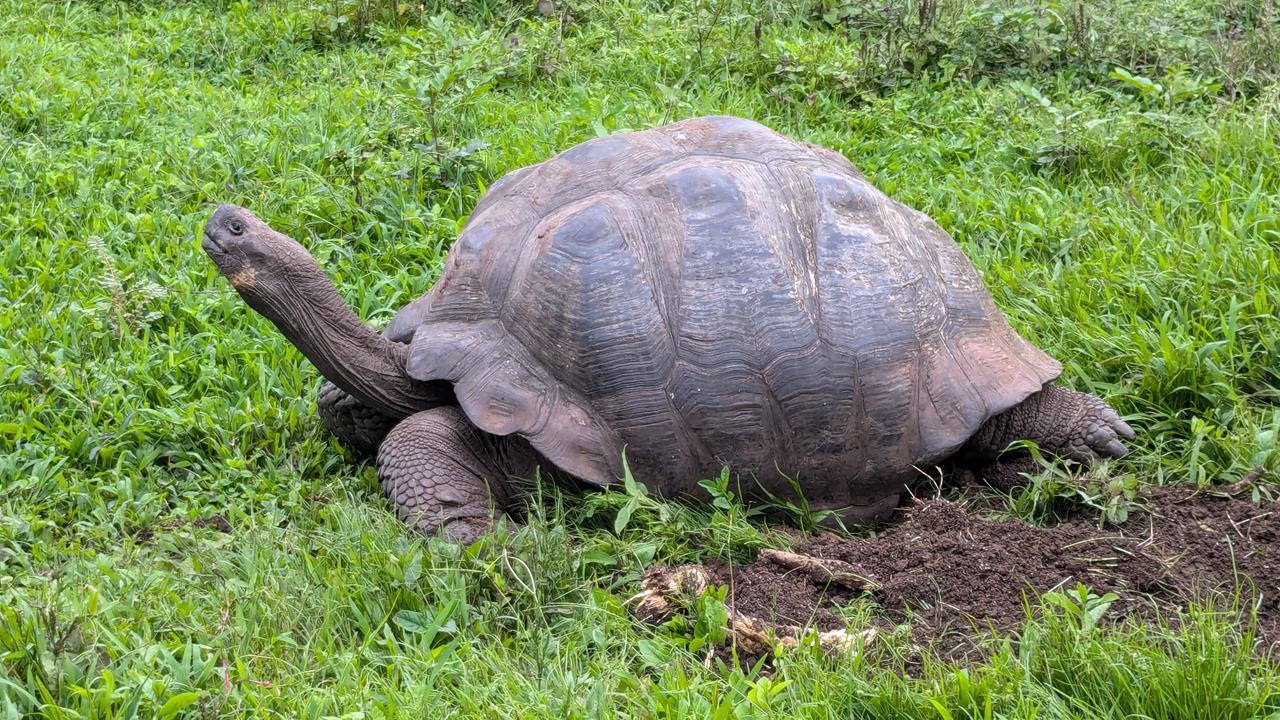
Giant Tortoise
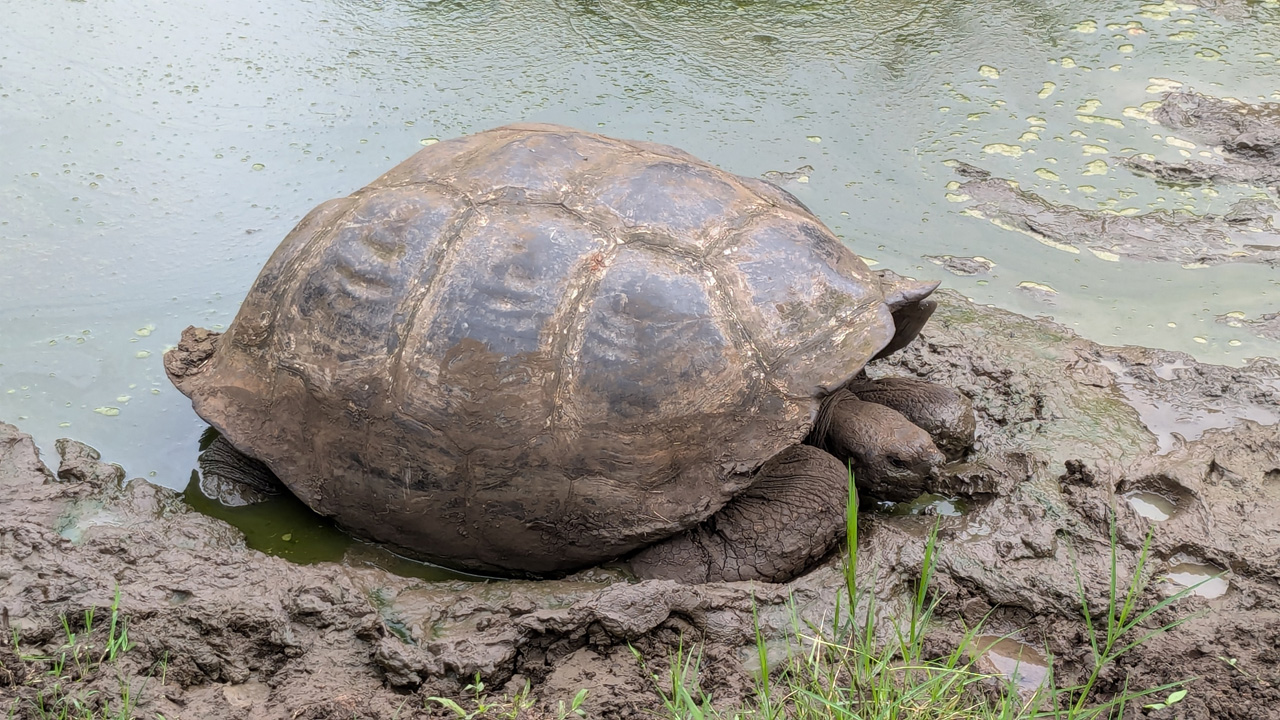
Apparently they love wallowing in mud!
Andy and I, of course, had already seen some on our way to and from Puerto Ayora, so weren't that bothered and we both agreed the stop there was a little too long.
xxx
However, the guide was knowledgable and I learnt a few things before we traversed a 'lava tunnel' beneath the reserve's grounds.
It was quite short and not very big compared to one I'd visited in Lanzarote, so while I always like a cave, I wasn't that excited about it.
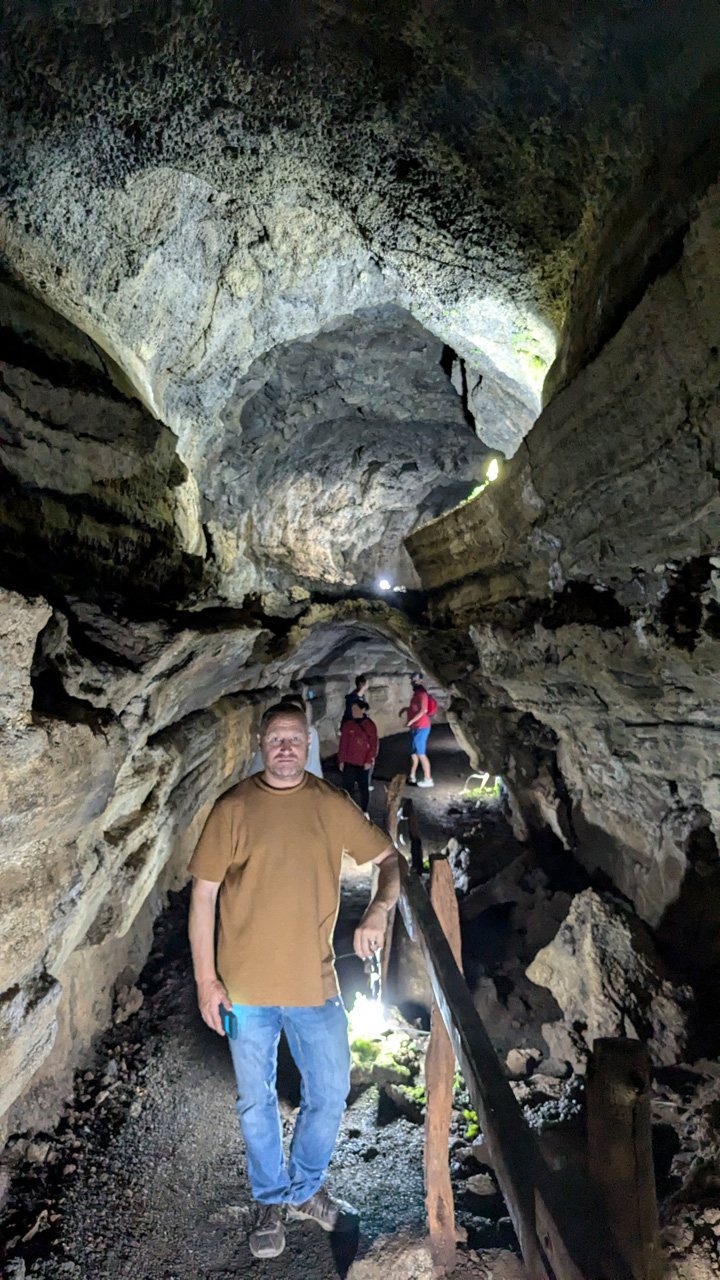
Andy in the Lava Tunnel
After that, the bus took us onto Puerto Ayora, where I purchased a T-Shirt in the shop Andy had bought his and some (very cheaply made, it turned out) earrings for Mandy and then we retired to The Rock to try a few more of their beers.
One of our guides, Christian, turned up and what started out as a quick beer ended up being a number of beers and shots for some people as our pickup time was pushed back an hour!
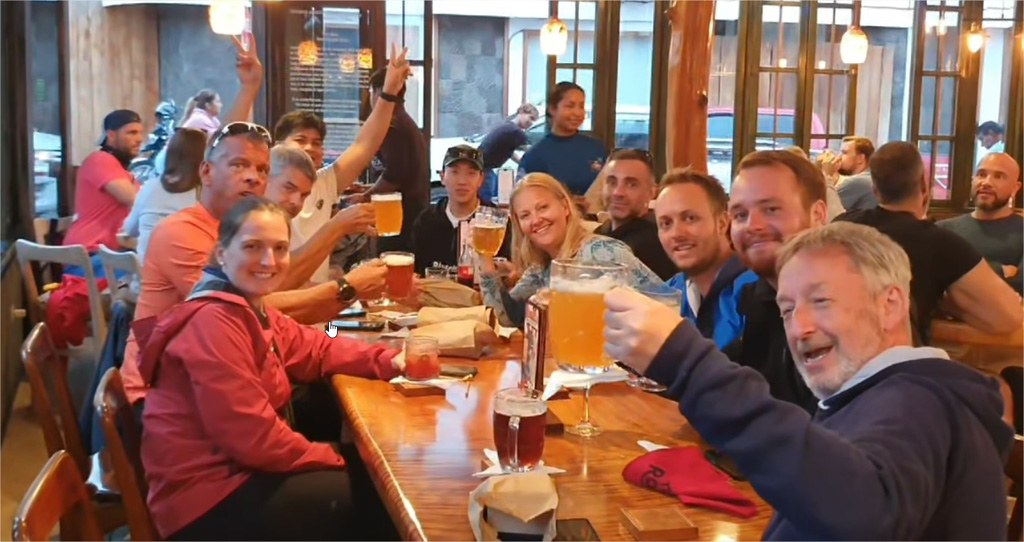
Most of our group enjoying a farewell drink...or two.
It was good, as most of the group were there and we had all got along well on the boat and we enjoyed a few beers and a laugh together on our last outing together.
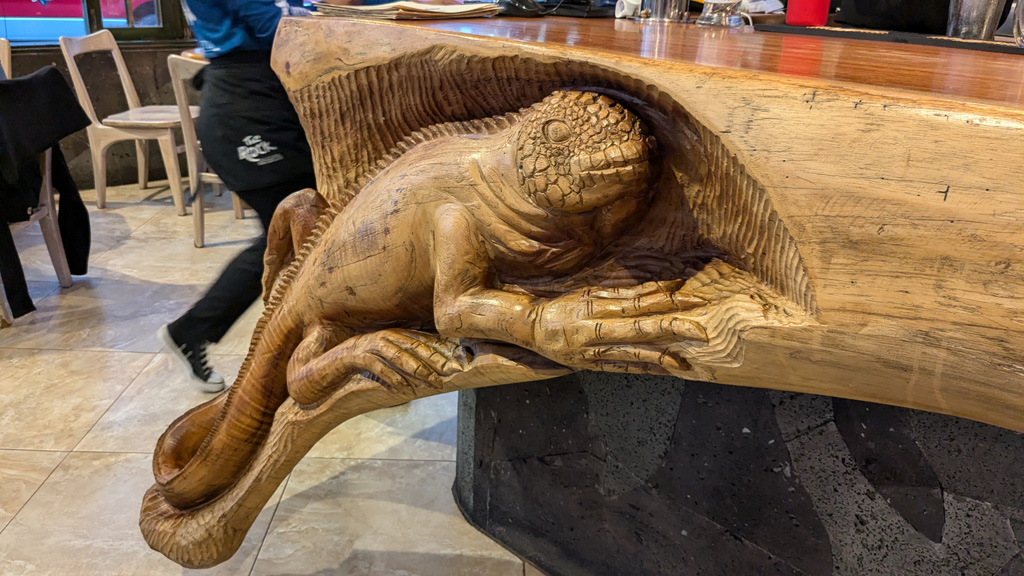
The bar in The Rock
We, therefore, got back to the boat quite late, but dinner was waiting and, as always, perfectly decent. It was much needed to soak up some of the beer.
After dinner, most people sat on the 'sun deck' and drank even more beer, until it ran out (It had run out two days before as well!) or watched the Galapagos sharks circling the boat and then, gradually, people retired to their cabins to get some sleep.
Homeward Bound
We were up early on the final morning to pack our dive gear away and load it onto the Zodiacs.
After breakfast and settling bills, we bid farewell to the boat crew and headed to the airport side of the ferry crossing, where we boarded the bus and set off back to the airport.
We dropped our main luggage off and wandered outside to enjoy an ice-cream in the Galapagos air before heading through to the departure lounge, where we found many of our fellow guests and said some more goodbyes to them.
Andy bought us both a warm snack that looked remarkably like a Cornish Pastie, but sadly it wasn't as tasty (more like a coronation chicken one) and microwaving the pastry probably didn't let us enjoy it at its best.
However, when we got to the gate, my name was called and apparently my luggage was damaged! I had visions of my bag being split open and dive gear scattered across the runway, but it only turned out to be the skids on the bottom of the bag, which some idiots had broken in Egypt on my last visit. They just wanted me to sign to accept it was already damaged, which I did.
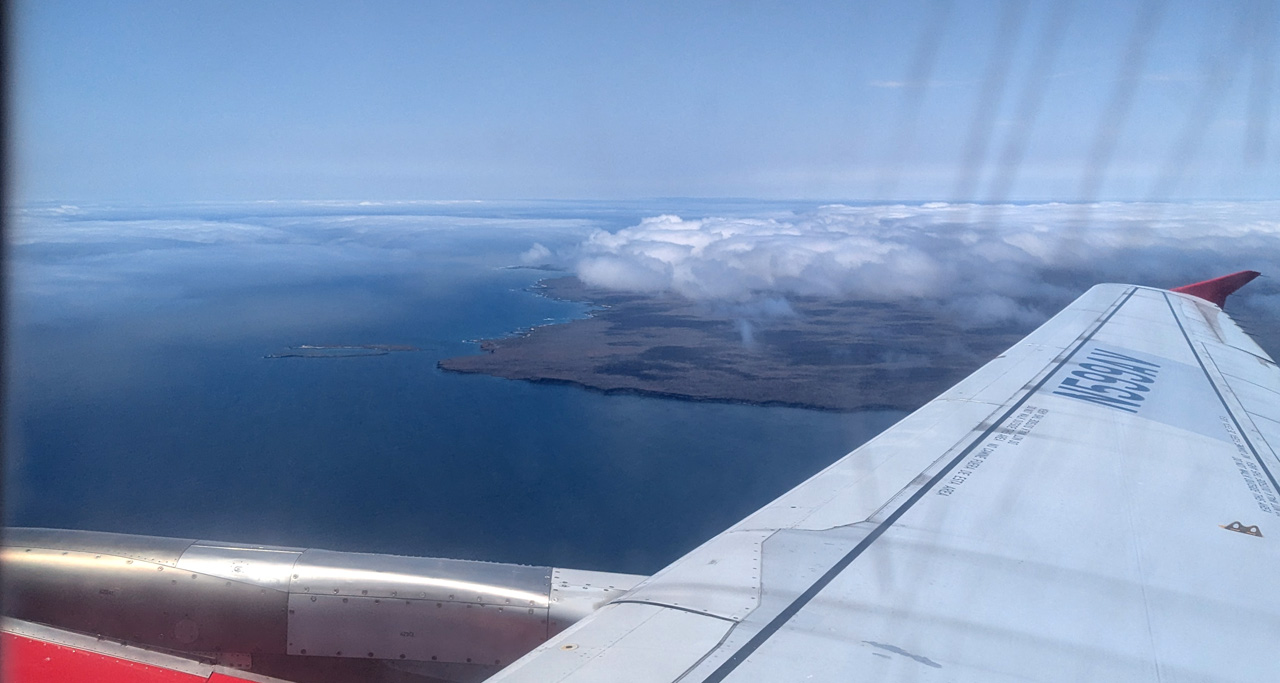
Farewell to the Galapagos Islands
Our plane, once again, pushed off exactly on schedule and we were soon seeing our last views of the Galapagos and not long afterwards back in Quito.
We dropped our luggage and even checked in our 'carry-on' to save the hassle of carrying it around Bogota airport.
Our 3+ hour stopover time passed quite quickly, but once again, as we were at the gate, my name was called.
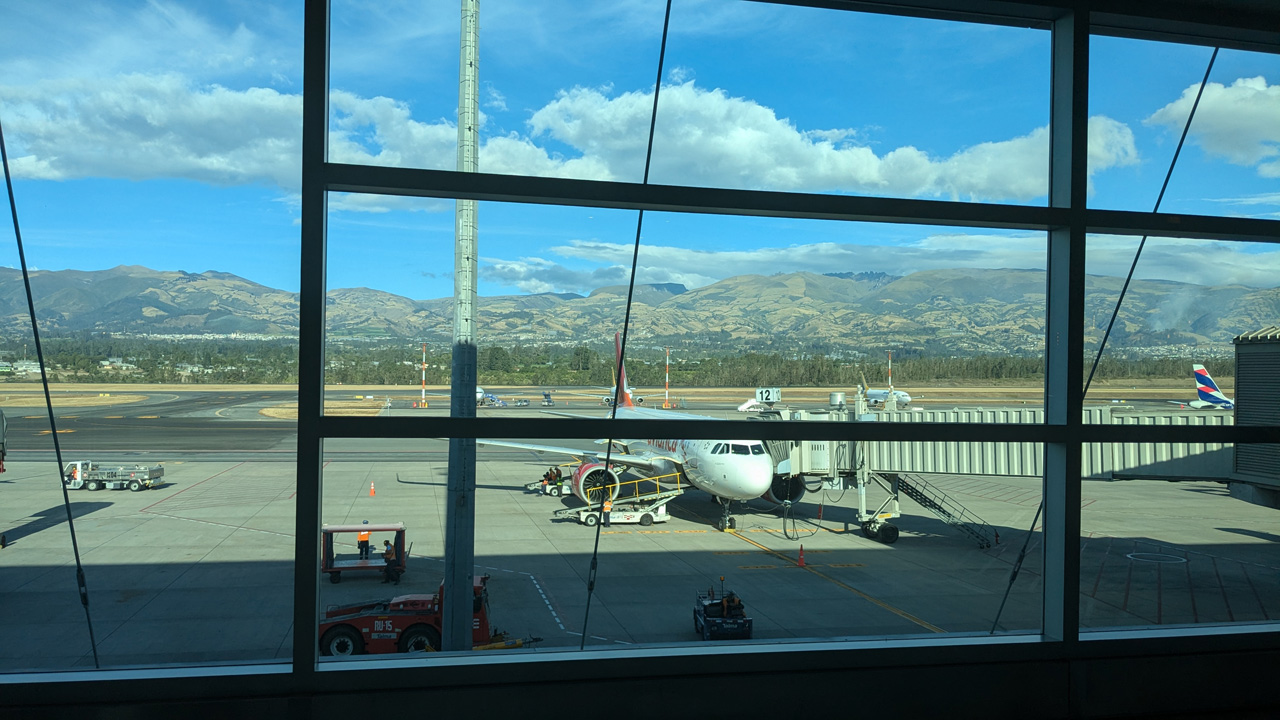
At the gate, Quito airport
This time my luggage was to be subject to a 'random police check'. While I didn't think I had any reason to worry, I did feel slight trepadation as I was accompanied down to the Ecuadorian Police check and a civil, but serious looking, policeman, went through my dive gear, being slightly suspicious of the masks tucked inside my dive boots for safety. There was no issue, of course (I did see one man with a bubble wrapped item being led away by two policemen!), but with about 30 minutes to departure time, I wondered whether my luggage would get on the plane!
We arrived in Colombia pretty much on time and faced another 4+ hour wait before we could finally board the (cramped, we already knew) flight back to Heathrow.
Andy 'enjoyed' a greasy burger (I passed on that joy), although he already wasn't feeling too well.
The time there seemed to pass very slowly, but the packed plane departed on time and, although I slept fitfully, I did get some sleep and we arrived back in London about 2:30PM.
Our luggage took a while to come out, but it had all made the flight, so that was a relief and Julia, Andy's wife, was there to meet us.
Reflections on the trip
This was by far my most expensive dive trip or holiday and I expect it will remain that way.
So was it worth it?
First off, I must thank Andy, my buddy and cabin mate for the week, for doing pretty much all the organising. He arranged the flights, the boat and the hotels, plus the transfers, so I pretty much just turned up and followed him, for which I feel grateful and a bit guilty.
I suspect, though, that trying to split the tasks might have made things more complicated - I'll stick to that as my excuse anyway!
The plan of spending a day in Quito and then Puerto Ayora seemed a bit of a case of overkill on the way out, but on reflection, I think it helped us acclimatise to being on the other side of the world and it defintely added to the experience, in an ideal world we might have split up the return leg, too, but that would have added even more cost to the trip. It certainly seemed more of a slog coming home than going out had been.
The boat was OK, it's very small, with small cabins and, at times (notably heading to Darwin), the 'lounge' seemed too small for 16 guests. If I ever go again (which I'll concede is unlikely), I'd defintely only go if I could afford a bigger, more luxurious boat.
You do, to an extent, get what you pay for.
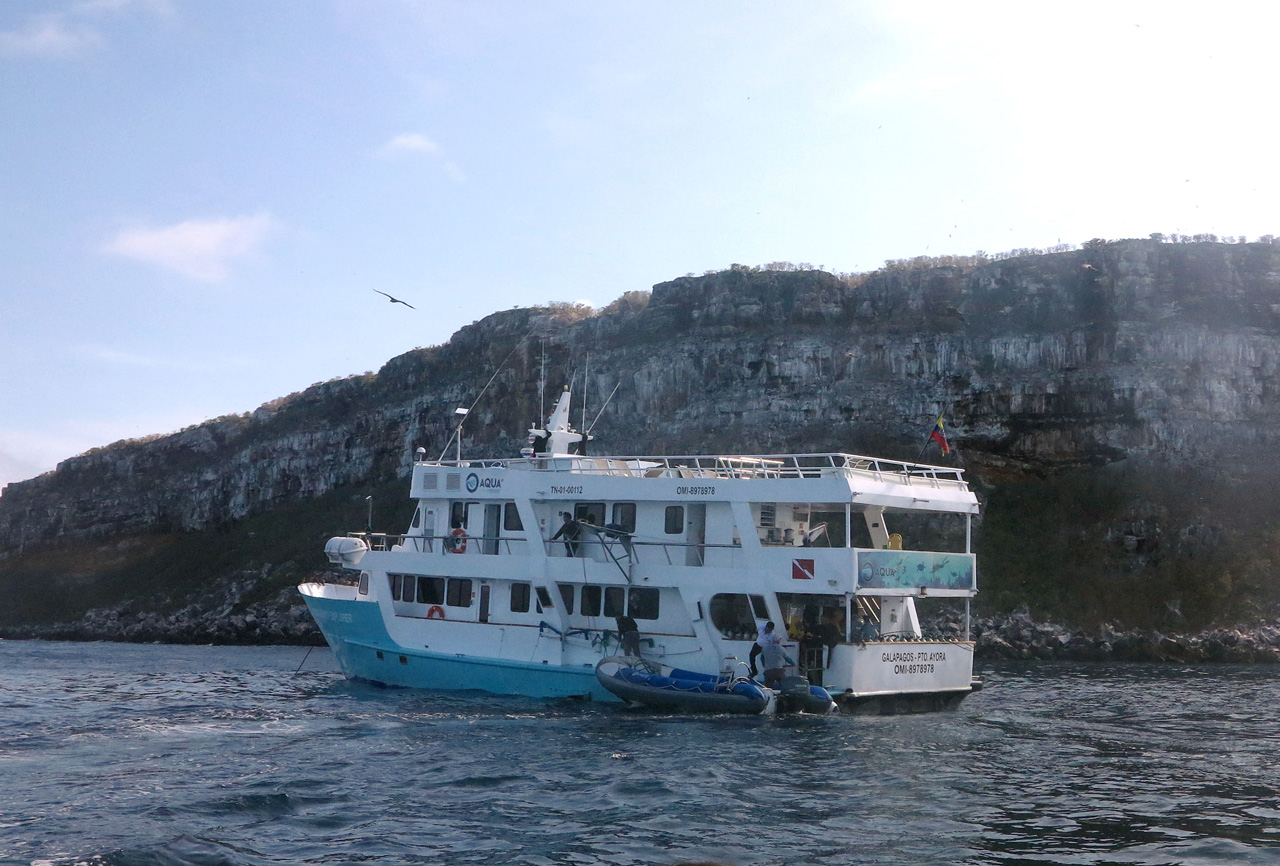
Penguino Explorer - Our base for the week.
Of course, the diving is pretty much the same whichever boat you choose and some people expressed some disappointment that we didn't see Whale Sharks (I wasn't too bothered) or Penguins (that would have been nice), but nature doesn't perform to order and I came away very satisfied with the number of Hammerhead and Galapagos sharks we had seen, the Iguanas were another big highlight for me and the Mola Mola a definite bonus.
The guides were friendly, but generally seemed a bit impatient with divers, rattling their rattles and then drifting on with the current, but not checking everyone had heard them - I don't think it was ever a serious problem, but I felt it could have been.
They didn't make much of an effort to monitor divers' gas either - Yes, you're supposed to have done 50 dives and yes, you should be able to monitor your own gas, but divers frequently came out with 10Bar and some came out with 0BAR showing, which, especially in strong currents, is taking a big chance.
The diving was far more challenging than the Red Sea and, while the ultimate force of the current never quite matched the strongest I experienced once or twice in the Maldives, it was often colder and varied a lot in force and direction, often switching mid dive! Vis, too, was far more limited than in the Red Sea or Maldives, let alone the gin clear Atlantic of the Azores.
An indication of the risks involved in the currents at Darwin and Wolf was that everyone was given a EPIRB (Emergency position-indicating radio beacon - An electronic beacon that lets ships locate you in open water) for these dives. It wasn't an option or an additional charge, everyone got one, such was the risk of being swept away in an unpredictable direction.
Most people adapted to it, but I'm not sure 50 dives ever, is really enough of a qualification - Andy, I and the more experienced divers had little problem, but some struggled for sure and it's definitely not 'easy' diving.
For me, what we did see made the trip completely worthwhile.
I don't think I'll ever forget looking down and seeing the sandy seabed obscured by hundreds of Hammerheads or the moment they burst over me when startled or the sight of 2 Mola Molas at a feeding station or the Iguanas swimming down to munch algae off the rocks. I could go on.
Basically, yes, it's a lot of money and yes, you can see sharks other places, but I 100% feel it was worth going and I would recommend it to any diver, just don't expect it to be warm, clear and calm diving - It most definitely isn't that!


